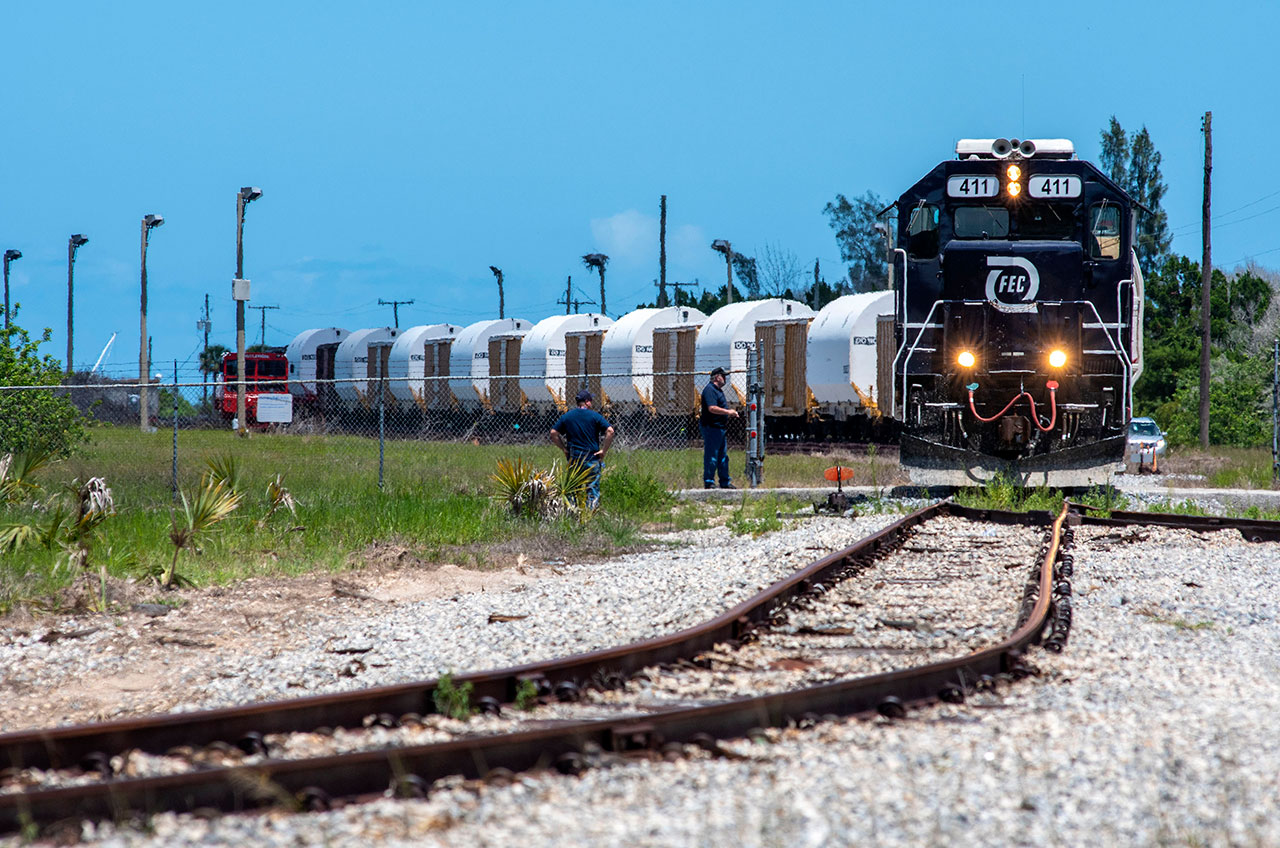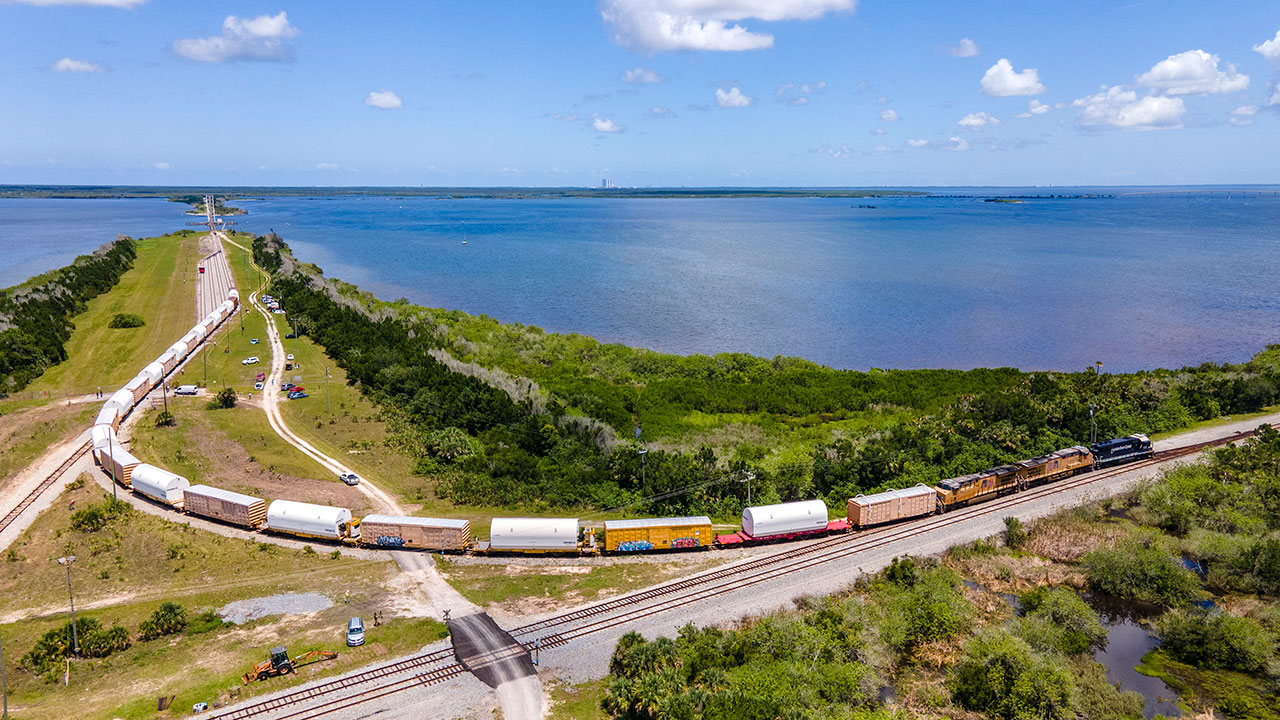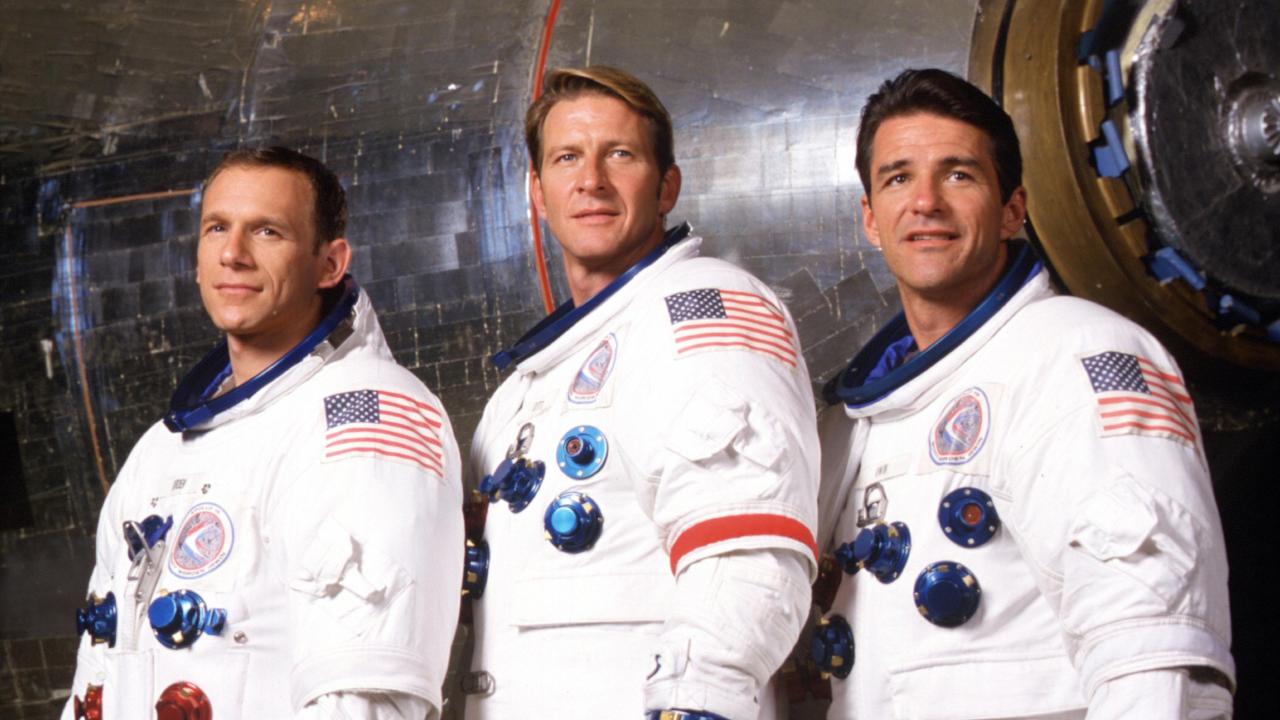Shuttle-flown solid rocket segments arrive in Florida for Artemis 1 SLS rocket

A solid rocket booster segment that helped launch the Hubble Space Telescope, send the space shuttle Endeavour on its maiden mission and return John Glenn to orbit has arrived back at NASA's Florida spaceport to lift off once again — this time as part of the first Space Launch System (SLS) rocket.
The steel cylinder, which will help form one of the two, five-segment motors to be mounted to the Artemis 1 SLS core stage, was among the hardware that was delivered by train to NASA's Kennedy Space Center on Friday (June 12). The segments' cross-country journey began seven days earlier at Northrop Grumman's facility in Promontory, Utah, where the hardware had been serviced and loaded with the solid propellant that will provide more than 75% of the initial thrust for the planned 2021 uncrewed launch.
The segments' arrival on the Florida East Coast railroad marked the first delivery of the booster hardware in just over a decade. The last shipment to the Kennedy Space Center in support of the space shuttle was on May 27, 2010.
Related: Coronavirus delays key tests of NASA's new SLS megarocket
Loaded onto individual train cars, the 12 segments that arrived on Friday included the 10 fueled segments that will launch on the Artemis 1 mission and two inert common booster segments to be used as test hardware for Northrop Grumman's OmegA rocket.
The Artemis booster segments will be the first elements of the SLS rocket to be stacked on NASA's new mobile launcher inside the Vehicle Assembly Building (VAB). They will eventually be joined by the SLS core stage, interim cryogenic propulsion stage, Orion spacecraft and launch abort system before rolling out to Launch Complex 39B for the circumlunar mission.
The SLS is NASA's primary launch vehicle for its Artemis program, which has the goal of returning astronauts to the moon by 2024. The SLS will then be used to support establishing a sustained presence on the moon in preparation for sending the first humans to Mars.
Get the Space.com Newsletter
Breaking space news, the latest updates on rocket launches, skywatching events and more!

"New technologies and material upgrades enable the boosters to meet the high performance demands of SLS, the most powerful rocket NASA has built to date," Charlie Precourt, vice president for propulsion systems at Northrop Grumman and a former NASA astronaut said in a statement. "Our technology will help propel the first woman and the next man to the moon."
All together, the Artemis 1 solid rocket booster segments previously helped launch 40 space shuttle missions dating back 30 years.
The oldest cylinder, which will fly as part of the booster mounted on the right side of the SLS core stage, first lifted off on the STS-31 mission with the Hubble Space Telescope on April 24, 1990. It was then used for six more shuttle flights, including Endeavour's debut on STS-49 in 1992 and STS-95 in 1998, which lifted off with Mercury astronaut and senator John Glenn as part of its crew.

Other notable missions that are part of the Artemis 1 boosters' legacy include: STS-71, which marked the first shuttle docking with the Russian space station Mir in 1995; STS-93, which deployed the Chandra X-ray Observatory and marked the first spaceflight commanded by a woman, Eileen Collins, in 1999; STS-114, the return to flight after the loss of the space shuttle Columbia in 2005; and STS-133, the final launch of the space shuttle Discovery in 2011.
The hardware also includes new components, including the two forward domes, two cylinders and four stiffeners.
The Artemis 1 mission will mark the final launch for all of the hardware as unlike during the space shuttle program, the solid rocket boosters will not be recovered after they splash down in the ocean due to budget constraints.
A schedule for stacking the booster segments has not yet been released. Though the mobile launcher stands ready and the modifications to Pad 39B have been completed, the Artemis 1 SLS core stage must first pass a series of "green run" engine tests at Stennis Space Center in Mississippi before it can join the mission's other components in Florida.
Click through to collectSPACE for the full history for the Artemis 1 solid rocket boosters.
- Over budget, behind schedule: NASA's SLS rocket faces congressional review
- Kablam! Watch NASA crush a SLS megarocket fuel tank until it explodes
- NASA has a plan for yearly Artemis moon flights through 2030
Follow collectSPACE.com on Facebook and on Twitter at @collectSPACE. Copyright 2020 collectSPACE.com. All rights reserved.
OFFER: Save 45% on 'All About Space' 'How it Works' and 'All About History'!
For a limited time, you can take out a digital subscription to any of our best-selling science magazines for just $2.38 per month, or 45% off the standard price for the first three months.
Join our Space Forums to keep talking space on the latest missions, night sky and more! And if you have a news tip, correction or comment, let us know at: community@space.com.

Robert Pearlman is a space historian, journalist and the founder and editor of collectSPACE.com, a daily news publication and community devoted to space history with a particular focus on how and where space exploration intersects with pop culture. Pearlman is also a contributing writer for Space.com and co-author of "Space Stations: The Art, Science, and Reality of Working in Space” published by Smithsonian Books in 2018.In 2009, he was inducted into the U.S. Space Camp Hall of Fame in Huntsville, Alabama. In 2021, he was honored by the American Astronautical Society with the Ordway Award for Sustained Excellence in Spaceflight History. In 2023, the National Space Club Florida Committee recognized Pearlman with the Kolcum News and Communications Award for excellence in telling the space story along the Space Coast and throughout the world.
-
newtons_laws The article states "The Artemis 1 mission will mark the final launch for all of the hardware as unlike during the space shuttle program, the solid rocket boosters will not be recovered after they splash down in the ocean due to budget constraints. "Reply
So the SLS launch vehicle will have no re-usable elements? Compared to what SpaceX are doing with reusability this seems so backward. Is it really the case that it works out cheaper overall to discard the solid rocket booster segments rather than as previously recover and re-use them? -
Hughjer Not to mention that they are "re-using, just once" leftovers from the Space Shuttle program? Did they not have enough money to budget in new designs and materials either? Trying to dust-up old nostalgia alone will not get it done... especially when they will just be permanently ditched into the ocean. The Space Shuttles were based off of technologies that are over 5 decades removed now, with two catastrophic failures out of four working shuttles. SpaceX seems to be the future for all the right reasons, meanwhile NASA is still moving sideways.Reply -
kelpypony In light of currently super famous other options, deliberately dumping rocket junk in the ocean strikes me as an ugly, backwards, irresponsible thing to do at this time.Reply -
B.L. Alley Once again NASA desperately clings to the past and their traditional partners, in spite of the fact private companies like Space X and others are not only advancing space technology but doing it for a fraction of the cost. Boeing received almost twice the money as Space X yet can't even get unmanned Starliner to the ISS and back, even though they are using Apollo-era ideas. The only real updates are a bracket for an iPad next to the control panel and air bags to land on dry ground, but Space X is already well past that with Crew Dragon being able to conduct propulsive landings. Unfortunately, that made Starliner and Boeing look bad, so NASA refused to certify Crew Dragon for powered pad returns. The integrated Super Dracos are still used for launch abort instead of a separate disposable tower, but that's like installing two motors in a Tesla but leaving one disconnected.Reply
NASA will never live up to its potential as long as creatively bankrupt bureaucrats like Jim Bridenstine are in charge. -
johnmiller ReplyB.L. Alley said:Once again NASA desperately clings to the past and their traditional partners, in spite of the fact private companies like Space X and others are not only advancing space technology but doing it for a fraction of the cost. Boeing received almost twice the money as Space X yet can't even get unmanned Starliner to the ISS and back, even though they are using Apollo-era ideas. The only real updates are a bracket for an iPad next to the control panel and air bags to land on dry ground, but Space X is already well past that with Crew Dragon being able to conduct propulsive landings. Unfortunately, that made Starliner and Boeing look bad, so NASA refused to certify Crew Dragon for powered pad returns. The integrated Super Dracos are still used for launch abort instead of a separate disposable tower, but that's like installing two motors in a Tesla but leaving one disconnected.
NASA will never live up to its potential as long as creatively bankrupt bureaucrats like Jim Bridenstine are in charge.
Agreed! Time to move into the future. -
newtons_laws Rather than spend so much money on a non re-usable heavy lift launcher NASA would do better using SpaceX's re-usable heavy lift launchers and if they are serious about ever sending manned missions to Mars developing nuclear thermal rockets for the propulsion stage to Mars which would drastically reduce the journey time compared to chemical rocket propulsion - that is the sort of advanced technology which NASA as a government organisation is best equipped to undertake in view of the nuclear regulatory aspects. /nuclear-propulsion-future-spacecraft-nasa-chief.htmlReply


